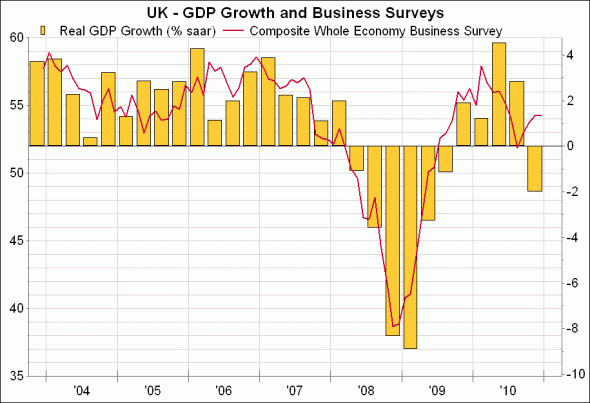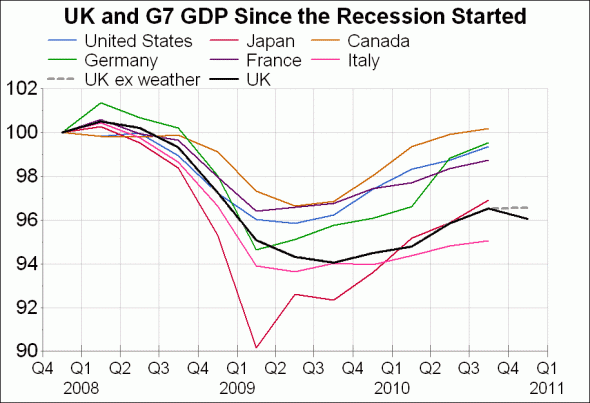The UK GDP figures for Q4 2010 have been eagerly awaited far beyond Britain's shores, because the country is currently being seen as a laboratory experiment in what might happen when the rest of the world tightens fiscal policy. The statistics were expected to show a significant slowdown in output growth, but nothing like the drop of 0.5% in real GDP (-2 per cent quarter-on-quarter annualised) which was actually announced this morning.
Given that this has occurred just when the fiscal tightening has started to take effect, it is likely to lead to much talk about a double-dip recession. But these figures seem much too bad to be true, and not just because of the weather. The underlying growth rate of private sector GDP probably remains at around +2 per cent on an annualised basis, and it would not be at all surprising to see a sharp rebound in recorded growth in the current quarter. Nevertheless, the recovery in the UK economy, while still intact, continues to run at a less impressive pace than we are seeing elsewhere in the developed world.
The official statistics for real GDP dropped by 2.0 per cent in Q4 (quarter-on-quarter annualised), and the ONS reports that virtually all of this decline has been caused by the exceptionally bad weather in December, which prevented people from getting to work, and stopped the distribution of goods in the economy. Without this, the ONS therefore reckons that growth in the quarter would have been about zero, which is still a very disturbing outcome, and likely to be far worse than any of the other G7 economies report in the quarter (except possibly Japan). However, there are other mitigating factors which need to be taken into account.
First, the decline in construction (which was to be expected after the temporary surge in the public sector's building activity last summer) knocked about 0.8 per cent off the annualised growth rate this quarter. While this clearly reflects the early results of fiscal tightening, it should not be taken as a reliable warning of what might happen to the private sector more generally as the budgetary changes take their full effect on the economy. On that front, the recovery in the production industries (which recorded 3.6 per cent annualised growth in Q4) might in fact be taken as an encouraging sign.
Second, today's GDP figures do not seem to give anything like the same message as the business surveys which have been published during the quarter. The first graph shows that the composite business surveys for the manufacturing and services sectors are normally quite closely correlated with quarterly GDP growth. This relationship broke down somewhat in 2010 Q2 and Q3, when the official GDP numbers were considerably higher than business surveys had been suggesting. At the time, it seemed that a rebound from last winter's cold weather, and a surge in public construction, had probably exaggerated the true health of the economy.
The first graph shows that the composite business surveys for the manufacturing and services sectors are normally quite closely correlated with quarterly GDP growth. This relationship broke down somewhat in 2010 Q2 and Q3, when the official GDP numbers were considerably higher than business surveys had been suggesting. At the time, it seemed that a rebound from last winter's cold weather, and a surge in public construction, had probably exaggerated the true health of the economy.
That conclusion has now been confirmed by the weak Q4 data, where the opposite effects have been felt. The business surveys indicate that underlying private sector GDP growth was about 2 per cent annualised in Q4, which is probably not that far below the true underlying rate in the previous two quarters. So while the official GDP data have exaggerated both the strength of the economy in Q2 and Q3, and the weakness in Q4, the truth has probably been somewhere in between throughout 2010.
Taking a slightly longer term view, the recovery in the UK economy remains somewhat sluggish compared to other G7 economies. The second graph shows how GDP has behaved in all the major developed economies since the recession started in 2007 Q4. The UK had a deeper recession than several other economies, and took about a quarter or two longer to hit bottom. Since then, the recovery has been at a slightly slower pace than elsewhere in the G7, and that assessment will probably be reinforced by the Q4 data, even if we exclude weather and construction effects.
The second graph shows how GDP has behaved in all the major developed economies since the recession started in 2007 Q4. The UK had a deeper recession than several other economies, and took about a quarter or two longer to hit bottom. Since then, the recovery has been at a slightly slower pace than elsewhere in the G7, and that assessment will probably be reinforced by the Q4 data, even if we exclude weather and construction effects.
What has caused the UK to under-perform some other G7 economies since 2007? That is a longer story, but I would point to a drop in oil and mining output, which has knocked about 0.6 per cent off total output in the period covered by the graph. This is a result of the fact that North Sea output has now started a long decline which cannot be prevented. In addition, business and financial services, to which the UK is particularly exposed, has reduced output by 1.2 per cent over the relevant period. Without these two factors, the under-performance of the UK since the recession started would have been much less, though still not zero.
As regards the consequences of today's rather odd set of GDP data for monetary policy, I would hope and expect that the MPC will be able to look through the statistical distortions which have severely clouded the picture. The private sector is probably continuing to grow at a pace which is consistent with stable or slightly rising unemployment, and a continuing fairly large output gap. None of this has changed today. The inflation pressures which are in the system, and which are clearly very uncomfortable, should be seen in that context, especially since the further planned fiscal tightening could slow the GDP growth rate during the next two years. Unless pay settlements or price expectations become unhinged from their recent rates, the MPC will probably try to avoid an increase in interest rates for a while longer.

No hay comentarios:
Publicar un comentario